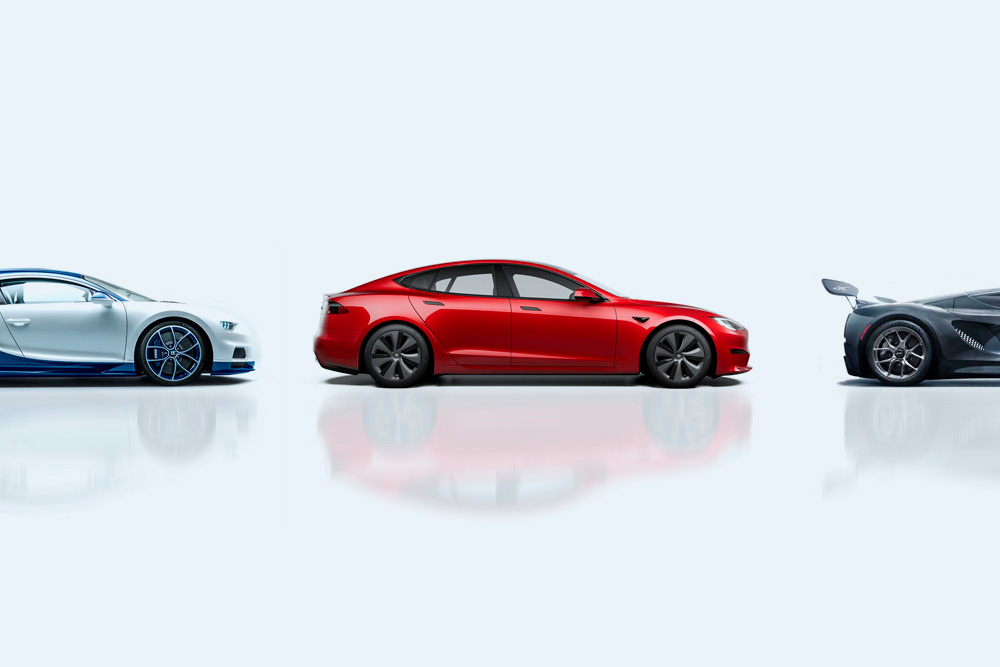S h a r e
How Tesla went from fast to absolutely bonkers


Posted by
Kevin Blackmore
December 2024
When Martin Eberhard and Marc Tarpenning founded Tesla in 2003, their aim was to be a car manufacturer and technology company. Over twenty years later, the original founders are long gone, but Tesla’s dominance in the electric car space directly results from that original aim.
In much the same way that technology company Apple disrupted the music industry with the original iPod and then the mobile phone industry with the iPhone, Tesla has made technology—not the driving experience—the disruptive force behind the company’s meteoric success. This has forced the rest of the car industry to accept that, just like the iPhone, it’s not about the product—it’s about the technology.
The Model 3 and its sibling, the Model Y, are now among the most popular electric cars in the world due mainly to clever technology. Not because they look gorgeous (they’re not the most attractive electric cars available) or are the most driveable (there are better-driving EVs on the road), but because the technology is impressive.
One only has to look at Volkswagen and its ID range of electric vehicles to see what a mess Europe’s largest automaker has made of its technology. Getting the technology right has cemented Tesla’s position as the global leader in electric vehicles. And where they lead, all other manufacturers are (by and large) still following.
So what makes Tesla, Tesla?
What, then, is Tesla’s formula for success? Technological ambition and ability are obvious, but exciting technology is another key ingredient.
Musk has taken a leaf from the Steve Jobs’ playbook and turned product launches into an art form. And while they don’t always go to plan, such as the famous ‘unbreakable’ Cybertruck window affair, the public lap it up. Would Volkswagen have had the bravery to unveil a weird-looking truck straight off the set of a cheesy 70s TV sci-fi show only to deftly announce it had a 500-mile range and that its tri-motor AWD drive could rocket it from 0 to 60mph in less than 2.9 seconds?
It doesn’t happen. Traditional manufacturers are not the showmen in this new technology-driven age.
Ultimately, news of the Cybertuck’s whacky design resulted in a 6% drop in Tesla stock, but a quarter of a million pre-orders followed by a highly successful launch that saw influencers and celebrities alike tout the vehicle’s head-turning looks made it clear that it’s the wow factor—not the driveability—that gets the buying public going.
So maybe that’s Tesla’s secret: make it technologically bonkers, and people will want it.
So let’s quantify ‘bonkers’ for a moment. BMW impressed early on with its i8 supercar, which entered production in 2014. It’s a classically exotic supercar with the sprinting stats to match: 0 to 62 mph in 4.4 seconds.
Tesla’s funky-looking sci-fi pickup blows the doors off the i8 supercar, however, with 0 to 60 in less than 2.9 seconds (while being made of super-heavy bullet-resistant sheet metal, obviously).
For perspective, the 250,000 pre-orders alone comfortably saw off the entire production sales of the i8, which ended in 2020 at just over 20,000 units. With Tesla, you certainly get plenty of bonkers bang for your buck.

The Model S Plaid
That brings us to Tesla’s latest, wildest product yet—the Model S Plaid. We’re talking about Tesla on the global stage here, as sadly, Tesla inexplicably removed the Model S and Model X from all right-hand drive markets (including the UK) in May 2023. We’re holding out that Tesla will see sense and re-launch the Model S to these as the Plaid’s stats are pure bonkers.
Let’s get started with a few stats:
- 1,020hp
- 0-60 mph in just 1.9 seconds
- Top speed of 200 mph
- Aeroplane flight-yoke in place of a traditional steering wheel
- Fully-autonomous driving capability
- An infotainment system that is more powerful than a PlayStation 5
- A 17-inch cinematic display
- A 22 speaker, 960-watt sound system
The list above is the recipe for Tesla’s secret formula: a feature set of insane tech specs that makes the car a mouth-watering proposition. It doesn’t have the cachet of a Ferrari, but it’s a hugely exciting, headline-grabbing car.
Former US talkshow host and car enthusiast, Jay Leno, proved how exciting, by breaking a world record in the Model S Plaid, covering a quarter of a mile in just 9.25 seconds. According to Motor Authority, that’s quarter of a second faster than a Bugatti Chiron Sport and only 1.13 seconds behind the Czinger’s 21C hypercar – which is so exotic that it’s limited to a production run of just 80 units.
There’s yet more craziness if you then consider the practicality and value the Tesla represents compared with its quarter-mile rivals (or initially represented, prior to its removal from Tesla’s UK line-up).
For example:
- Tesla Model S Plaid: £118,900 (seats 5)*
- Czinger 21C hypercar: £2,000,000 (seats 2)
- Bugatti Chiron Sport: £2,700,000 (seats 2)
*Announced UK price-point before cancellation of launch.

The Model S Plaid is an order of magnitude cheaper, yet offers comparable performance and is a bonafide family car. How crazy is that?
The Model 3
While £118k is a lot cheaper than most other exotics, it’s hardly pocket change. But don’t worry – Tesla has you covered there, too. The Model 3 Performance offers equally mind-bending specs for almost half the cost.
Here’s a quick comparison:

Next to the Model S, the Model 3 lags behind. But let’s put this into perspective: the Model 3 is the world’s bestselling electric car and the 16th best selling car globally according to the latest data from Focus2Move. The Model 3 Performance is incredibly swift, yet to all intents and purposes, it’s part of Tesla’s entry-level range.
That’s, well…you’ve guessed it: bonkers! Tesla bonkers.
You also might like…
If you liked this article then check out our posts about similar topics
First Drive: Why Audi’s Q4 e-Tron matters
The Company Car Sweet Spot for future-proofing your Fleet An Audi badge says professional without drifting into show-of...
First Drive: Jaecoo 7 – Range-Rover Looks on a £30k Budget
Why this newcomer matters China’s Chery Group is taking the UK by storm with a two-brand strategy: Omoda targets mains...
Good-enough lease rates aren’t good enough anymore: Introducing Multi-Bid Tendering
In a climate of persistent inflation, unpredictable tariffs and relentless cost pressure, “we’ve always done it this...
Become a Fleet Alliance business partner
I am writing to you about the opportunity to become a business partner of Fleet Alliance The commercial arrangement a...
Charting a Greener Course: Chris Rowthorn signs the Business Wales Green Growth Pledge
When seasoned automotive finance professional Chris Rowthorn left MotoNovo after more than two decades to become a Flee...
Outsourcing Your Fleet: 10 Reasons Fleet Alliance Makes Perfect Sense for Busy Fleet Managers
Running a large corporate fleet means you’re under constant pressure to hit cost, compliance, and sustainability targe...
What makes Fleet Alliance a winner in the SME fleet sector?
We all like an award, an additional trophy for the cabinet - the recognition is important and it’s always good to rece...
10 great cars to have on salary sacrifice 2025
Employers and employees are really catching on to salary sacrifice because you can drive a brand new electric car (EV) a...
Ready to make the management of your fleet more efficient?
Request a call back
